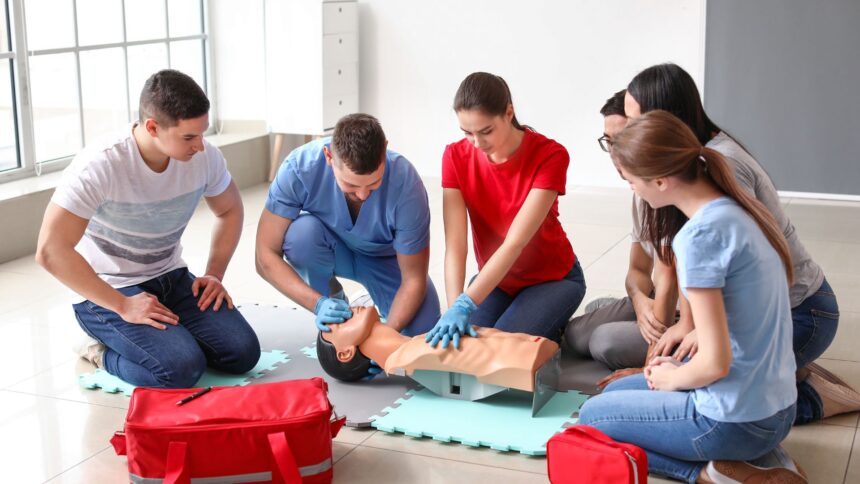Introduction
Healthcare workers play an indispensable role in providing quality patient care at all times. Knowing how to perform CPR (Cardiopulmonary Resuscitation) correctly is one way to ensure that you are ready for emergency situations. CPR involves chest compressions and rescue breaths, which help maintain blood circulation and oxygenation when someone’s heart or breathing has stopped. For healthcare workers, getting certified in CPR is not just a requirement but a necessity. These skills are necessary, especially during cardiac and respiratory emergencies, which can happen anytime. Learn the importance of getting your healthcare CPR certificate and the benefits associated with it.
Importance of healthcare CPR training
Healthcare CPR training will allow you to make prompt decisions and respond effectively during cardiac emergencies. Research shows that identifying an emergency and administering CPR right away can improve the chances of survival, especially before a person reaches the hospital, or advanced medical help arrives. Knowing how to administer CPR efficiently also improves your confidence in performing the techniques, and enables you to respond during such situations calmly.
Let’s take a look at the different types of people that can take healthcare CPR training:
- Medical and healthcare professionals
As a member of the healthcare or medical industry, you need to have a valid CPR certification. This validates your ability to perform emergency procedures and keep patients stable.
- General Public
As a layperson, you too can get basic healthcare CPR training. This will enable you to act promptly during emergencies with family, at the workplace, or within your community.
Understanding basic life support (BLS)
BLS involves life-saving techniques that help in blood circulation and oxygen flow during a life-threatening emergency. Here is some basic information about BLS that you must know:
- Basics of BLS
As the foundation of CPR, BLS skills require you to know how to deliver chest compressions, manage airways, and deliver rescue breaths. Being trained in BLS equips you with the ability to identify emergencies promptly and respond effectively.
- Role of BLS in CPR procedures
Understanding BLS techniques is crucial for performing CPR effectively. It ensures proper circulation and oxygen delivery to the brain and other vital organs. Administering BLS properly can improve the likelihood of successful resuscitation and reduce the risk of brain injury or organ failure.
- Different aspects of BLS
BLS comprises various aspects such as:
- CPR: You first need to identify signs of distress and recognize an emergency. Once this is done, you can administer CPR to adults, children, and infants.
- Use of automated external defibrillators (AEDs): AEDs are portable devices used to restore normal heart rhythm by giving electrical shocks to restart the heart.
- Foreign Body Airway Obstruction (FBAO): Choking can obstruct the respiratory airways. BLS training will allow you to help a person to clear their airways from blockage and breathe normally again.
Until emergency medical services arrive, you need to continue to administer CPR through chest compressions and rescue breaths. While doing this, you must continuously monitor the patient for signs of recovery or fatigue.
Types of CPR training in the United States
In the United States, there are two forms of CPR training:
- Basic CPR Certification
This will teach you how to properly administer CPR and use the AED on adults, children, and infants.
- Advanced CPR certification
This program will allow you to learn advanced skills like ventilation and airway control.
Benefits of consistent CPR training
Constantly updating yourself and renewing your CPR training shows your commitment to your profession as a healthcare provider. Training builds confidence and equips you to address emergencies seamlessly. Here are some benefits of getting your CPR training:
- Less hesitant
With the right CPR training, you will become less reluctant or hesitant to perform the techniques during times of distress. Knowing exactly what to do in a tough situation will help you manage the situation properly and save someone’s life.
- Better skill retention
Regular CPR training will help you retain skills and knowledge better. Regular practice builds muscle memory and ensures you can easily perform CPR when you need to.
- Adapt to the latest guidelines
CPR standards keep updating, and it is important for you to know about the latest changes and guidelines. This will help you deliver the best care to people during emergencies.
- Empowers communities
As a member of a community, knowing CPR makes you very valuable. You can intervene and respond to emergencies in a way that can save lives.
Conclusion
CPR certification is an essential skill for healthcare professionals and the general public. It gives you the knowledge and confidence to respond quickly during cardiac emergencies. By learning healthcare CPR techniques, you can create a safer environment.






